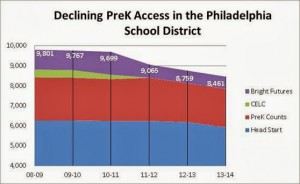Last year the School District announced its Action Plan to “prioritize early literacy” by “working with our partners to increase the number of high quality pre-K seats across the city.” So, one year in, how are we doing? This year sees a nearly 300-seat change for Pre-K in the District. Unfortunately, it’s 300 seats in the wrong direction. Even worse, this is the fifth straight year that number has dropped. It’s dropped 13% in the last three years alone.
Nearly 17,000 children are enrolled in kindergarten classes in in Philadelphia each year and the overwhelming share of them come from very poor families. Since 2009, the school district has lost 1,340 Pre-K seats. The District’s Action Plan points out, “The return on investment achieved by prioritizing early childhood education is indisputable. Children who participate in high quality early childhood education programs are significantly less likely to be placed in Special Education, drop out of school, become teen parents, or commit a violent crime.” So what accounts for the precipitous drop in access?
The District relied on funds from the state in the form of the Accountability Block Grant (ABG) and federal government (Title I and Head Start) to cover the cost of its Pre-K seats. On top of federal sequestration cuts of 5% cut to Head Start and a gradual 16% decline in Title I funding over the last three years, the state cut the ABG by 60% in 2011.
Remember all those things the District said about children who participate in high quality early childhood education programs? For many children in Philadelphia, pre-K, either in a traditional Pre-K or Head Start class is their only chance, and it is being pulled away. We know that Pre-K can be the difference when it comes to graduating high school, enrolling in college and escaping the cycle of poverty. Kids in suburban and private schools often already have a leg up on their inner-city counterparts; this just puts the city’s kids further behind.
But it’s not just kids that get hurt by these cuts. Studies have shown that for every dollar spent on high quality early childhood education, $7 is returned to society in savings. Forget stealing candy from babies, this is stealing bread off our tables. Taken the other way, every dollar cut is seven dollars out of our pockets. Some savings.

